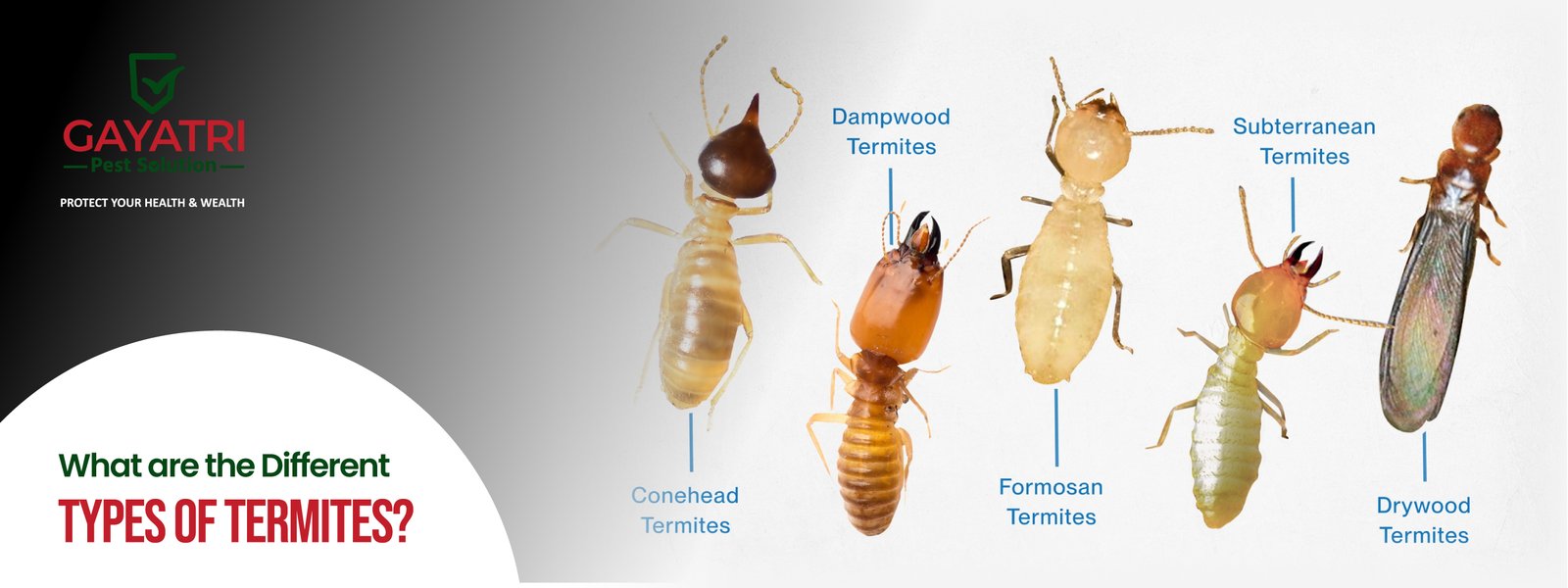What are the Different Types of Termites?
They are tiny, quiet, and they are always working, but not in a replenishing way. We are talking about termites, the wood-chewing creepy-crawlies that can secretly eat away at your furniture, doors, and, yes, even the core structure of your home. But you can take professional help from Gayatri Pest Solution, who provide the best Termite Control Service in Ahmedabad. You may think a termite is a termite only, but …! There are various kinds of termites, and each marches into your space in its sneaky way.
But if you’ve ever pondered which termite is eating through your house, or you only want to steer clear of damage down the road, we have you covered with this guide to understanding the primary termite types, how they function, and where they’re hiding out. Let’s get started!

1. Subterranean Termites! Masters of Mud Tunnels
When it comes to destruction, subterranean termites are the most notorious. These pests live underground and build long, pencil-sized mud tubes to reach their food source—usually your wooden walls, beams, or flooring. These termites establish large colonies—up to millions at times—and operate around the clock.
- What they love: Damp soil and anything containing cellulose (wood, paper, etc.).
- Look out for: Mud tubes on walls or foundations. This is the highway they travel along to stay safe and wet as they come and go.
- Where they live: Basements, crawl spaces, and foundations of homes.
Quick tip: If you spot mud tubes on your walls or near your home's base, it’s time to call a pest professional!
2. Drywood Termites! The Silent Intruders
Unlike subterranean termites, drywood termites do not require soil contact. They live right in dry wood—furniture, attic beams, window frames, even picture frames. You can go for years without realizing you have them, as they munch away inside wood with few visible signs.
- What they like: Dry wood without treatment.
- Where they live: In furniture, wooden ceilings, and wooden fixtures.
- What to look for: Small droppings that resemble sawdust and a hollow sound of wood when knocked.
Heads-up: Drywood termites don’t create mud tubes, so they can be challenging to find until they’ve done real harm.
3. Dampwood Termites! Moisture Lovers
As their name suggests, dampwood termites like the moist or decaying wood. They are larger than other termites and need moisture to survive, so you will not usually find them indoors unless there is a moisture problem that persists.
- What they love: Wet wood, decaying logs, water-damaged timber.
- Where they are found: Around leaking roofs, bathrooms, and anywhere with excess moisture.
- Prevention tip: Keep wood dry, tend to leak promptly, and maintain good air circulation in moist spots.
They’re less frequent in urban homes, but a real risk in perpetual-moisture settings.
4. Formosan Termites – The Aggressive Invaders
Often referred to as the most destructive of all, Formosan termites are originally from Asia and have gained a strong reputation for causing extensive structural damage. They shred wood at rapid speed and build massive subterranean colonies.
- What they love: Almost any kind of cellulose — wood, books, insulation, and so on.
- Where they show up: The foundation of your house, its walls, roof, and — yes — even boats.
- Why worry: A single Formosan colony can ravage large sections of a building in only a few months.
Even if you live in a region where these termites are known to inhabit, annual inspections are a necessity.
5. Conehead Termites – These are the Soldiers that march on Top of the Ground
Conehead termites are fairly new pests that have made a name for themselves in a hurry. That makes them fast-moving and difficult to stop once they’ve settled in.
- What they love: Wood, cardboard, and anything cellulose-based.
- Where they go: Fences, trees, landscaping, and sometimes indoor wood structures.
- What sets them apart: They construct nests in high-up locations, and they don’t need the five mud tubes known as tell-tale signs for other termite species.
Danger: If you see strange termite activity above ground, don’t delay for long — conehead termites breed very quickly and are very difficult to eliminate by yourself.
Why You Need to Know What Type of Termites You Have
Understanding the types of termites helps not only in gaining insight, but it is also invaluable in terms of seeking prevention and control. Each species of termite behaves differently, so each variety must be treated differently. Incorrect treatment procedure due to confusion among the insects can worsen the condition.
For instance, a bait system that is effective on subterranean termites could be of no use when it comes to drywood termites that burrow within your antique furniture. Knowing what you’re dealing with helps you take the right steps from the start.
Final Thoughts
Nobody wants termites. But how to find them, what they love, and how they act is knowledge that gives you a powerful advantage. Each type, from the hidden colonies of subterranean termites to the furniture-loving drywood ones, to the aggressive Formosan invaders, poses its flavor of menace.
The best advice? Stay informed, inspect regularly, and don’t wait until the damage is done. Get help from Gayatri Pest Solution. If something seems amiss or if you notice mud tubes, droppings, or wood that sounds hollow, then it’s time to take action.
Your home is better than a termite buffet.